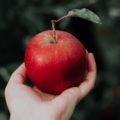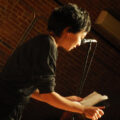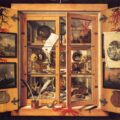White Spaces of Myth: Three Approaches to the Unsayable

The line breaks and white space inherent in poetry lends itself to fragmentation, juxtaposition, and implication, creating new modes of meaning outside of rational discourse, a vehicle to express the unsayable. Here the unsayable encompasses shame and trauma as well as experiences and feelings for which we don’t have a language, which don’t fit into an existing narrative. One example might be Vanessa Veselka’s GQ article, “The Truck Stop Killer,” about a serial killer who preyed on teenage girls on the road as well as her own brush with a man who might have been the killer himself. In a follow-up article, Veselka writes that the lack of female road narratives meant that women on the road were invisible and thought of as “already raped, already dead,” undeserving of our notice. In a similar vein, Cathy Park Hong coins the term “minor feelings” in her eponymous essay collection to describe “the racialized range of emotions that are negative, dysphoric, and therefore untelegenic,” a dissonance embedded in but not limited to the Asian-American experience. She names an emotional space that previously did not have a language to discuss it.
In poetry, more so than in prose, a writer can resist narrative. They can inhabit the space of the unsayable, collaging images, sounds, and other fragments to cast a light, however briefly, on what is hidden in our lives. Three recent books that do so – and some of my reading highlights of the disaster that was 2020 – are Cynthia Cruz’s Guidebooks for the Dead, Lauren Camp’s Took House, and Anna Maria Hong’s Fablesque. These three poets use shared cultural archetypes to explore the interior spaces of poverty, addiction, hunger, violence, absence, and survival. In the absence of established frameworks, they invent their own languages and approaches, showing us ways we can give shape to our stories in the daunting face of silence.
Guidebooks of the Dead is Cynthia Cruz’s sixth book of poetry, and in some ways, it feels like a culmination of the questions she began asking in her previous books. Cruz is a minimalist, her poems exceedingly short and spare, elliptical rather than direct, rich with imagery and sonic play. Her speakers are not rooted in time and place; they often appear to be speaking from a mysterious otherworld. She does not give them a backstory or motivations, these hallmarks of realism, but instead, especially in Wunderkammer (2014), she documents the shifting sense of self and the ways the mind obsessively dwells on the present tense of trauma, using images and objects to create a painfully personal archive of memory.
In this new book, Cruz conjures “a cast of extraordinary women [who] struggle to create amid violence, addiction, and poverty,” as the publisher’s catalog description says. Cruz focuses largely on French writer Marguerite Duras, best known for her novel The Lover, based on an affair she had with a wealthy Chinese man as an impoverished teenage girl in French Indochina. She also invokes Clarice Lispector, Hélène Cixous, and Ingeborg Bachmann, all women writers who wrestle with depicting the precarity of their lives on the page. Between these homage poems, a singular speaker summons glitter, gowns, and other trinkets of old-world glamour as she descends into madness, moving in and out of what she calls the “porcelain room,” the demands of femininity clashing with her inner turmoil.
Cruz often writes in series of poems with the same title. The “Duras” poems considers Duras’ life and writing from various angles, from her poverty and alcoholism to the mysticism and force of her writing. These musings – most of which are prose poems – are scattered throughout the book like shards. In one poem, Cruz writes, “Duras’ entire oeuvre springs from her gaze back at the wreckage. The wreckage gazes back at her and she becomes the wreckage.” As she considers Duras’ work along with Lispector, Cixous, and Bachmann, “These women writers understand that to say too much, to babble and garble is to take one’s place in the line of acquiescence, to participate in the unwritten Yes. Instead, they make a language of silence, leaving holes in their syntax, on the page for No, for But, Yet, for the stream of unheard voices to join in.”
In another series of poems, Cruz introduces the idea of the porcelain room, where “everything / Is broken, but terribly beautiful.” Porcelain is a recurring motif in many of Cruz’s books, a symbol of delicate aristocracy that is at once glamorous and confining: it is expensive, much effort is put into keeping it spotless, and it shatters easily. For Cruz, porcelain is both a symbol of aspiration as well as the silences demanded of the poor and abject:
The girls and women enter the room,
Gloved and covered in layers of lace.
Mothers and women
Without any children.
We stand in silence,
Our mouths painted crimson.
We are alone inside this,
What once was monstrous
Silence, but what is now
A cream and white procession.
But this porcelain room is also a space where these women can gather and find solidarity and agency in their struggles to create:
A silvering, like an endless poem
That goes on forever, each woman’s voice
Adding to her own jeweled song
To the procession until we are one,
Tethered together by our shared tales of terror
And trauma, bled
Together, a new family
Of voices. Like children singing
In choir, or a small band of girls
Erupting in joy
As they discover
Their own true voice.
The third series of poems is titled “Guidebooks for the Dead,” a play on the ancient Egyptian Book of the Dead. Where the Book of the Dead is a funerary text of spells that was buried with the deceased, Cruz’s “Guidebooks for the Dead” intersperse instructions for those living on the margins of society, “Drink tap water only in large cities. / Drink boiled water and thinned tea,” with the speaker’s own observations of life, especially that of mental illness, the “enchantment / Of children’s hospitals” and “the ice-cold floor / Of the locked hotel bathroom,” as well as the spells that she conjures out of lycra and stockings and “magic creams of medicine.” The dead here refers less to the deceased than to those cast out of society, the people who are rendered invisible by our capitalistic economy and essentially written off as dead.
In her essay collection Disquieting: Essays on Silence (2019), Cruz writes that non-communication, the depressive’s no, is a form of resistance and a refusal of neo-liberalism’s impulse to commodify all aspects of our lives. She also asks, in a culture that refuses to acknowledge the social realities of class, how can one write about that which is not supposed to exist, among which is the unspeakable shame of poverty? Cruz writes that she was raped at the age of eleven, a trauma that shook up her young life, but the muteness of her childhood and her anorexia stemmed from much larger social forces than the assault alone. Cruz’s circuitous method of incessant archiving, collecting and displaying a chorus of women who speak from a void, and propelling her lines with sound rather than logic, is an enactment of this refusal to participate in the culture’s delusions.
Writing is ultimately about communication, about finding the right frameworks to effectively convey ideas and emotions. Trying to depict non-communication, the spaces and silences of refusal, is a challenge on the page. On the one hand, it feels that this is the only way Cruz can access her truth, but she walks the fine line between obsession and duplication. Yet repetition also feels like part of her larger project, the obsessive archiving of trauma, the mind unable to escape from the echoes of, well, the porcelain room. In these echoes, Cruz seeks to fill the silences that have haunted her.
Where Cruz stings with biting lines that appear to be spoken from a darkness full of holes, on the surface, Lauren Camp’s Took House dwells in the pleasures of art and nature. Took House is Camp’s fifth book of poetry; prior to writing poetry, she had a 15-year career as a fiber artist, a medium in which she no longer works. Took House charts the dissolution of a relationship marked by absence and longing, but Camp does not give a backstory or setting. The man and the woman in the book are ciphers; they bear no identifying characteristics. Instead of developing a narrative of cause and effect, motivation and denouement, Camp suspends the reader in moments of lucidity in the relationship, the in-between state of wanting, almost getting, but not having.
The house in the title is in one sense a literal house, in which the woman once lived with the man, but it also feels like an enclosure, a cage in which the woman begins to lose herself. On an individual level, Camp’s poems can feel expansive, taking in the birds in the sky and the vibrant colors of an artist’s palette, but as she stacks them together, they begin to disassemble into the narrow spaces of the woman’s mind. Alcohol casts a shadow on the relationship; the man is not so much violent than absent, there but not quite there, unable to be fully present for the woman. In interviews, Camp has said that the underlying story is based on her own history, but these poems are not confessional in the sense that she does not collapse the distance between the speaker and poet. They are less about psychological revelation than inhabiting the liminal space of intimacy.
In an interview with The Rumpus, Camp says, “But don’t we all have a thirst, whether it’s for something that nourishes or something that removes us? I’m interested in such spaces of hunger, the empty parts desperate to be filled.” Camp evokes this space in the prefatory poem “Appetite”:
And now in the useless unceasing, there is a heart
in one part of town, where there is a table
that is most like a cliff, a place to render
fewer potentials. There is a glass
near a bottle that will offer what she asks.
In that room, or the next, is an intimate slowing
where the woman put down her shield
and took out her heart. She put it on the table
and looked at the table under the eye
of everything that could go wrong,
everything that did,
each direct change and the taking of it.
The heart, she writes, “is the largest / muscle and she let it / take over, she let it.” On the one hand, the woman is nursing a breakup, yearning for what she has lost, and yet her appetites are not just for love and sex, but rather to be seen in a profound way that erotic connection makes possible. What she wants most is, in Camp’s words, “knowledge, connection, history,” a sense of self not dependent on the approval of a man but rooted in an engagement with the world.
The remaining poems in the book are divided into two sections, titled “The Exact Color of Welcome” and “Days at Zero.” The first sifts through the ashes of the relationship; the second depicts the woman struggling not to be consumed by her unmet desires within the relationship. Camp refracts this story through multiple lenses. Like Cruz, Camp essentially has three series of poems in the book: first-person narratives and testimonies, such as “The door found its exit but stayed half inside when I ambled over stones to watch the pitch of his mouth, my name when he said it, a point of view I accepted,” encounters with nature, especially hawks and eagles, birds that represent both flight as well as the violent hunger of animal need, and ekphrastic poems that engage with works by visual artists such as Georgia O’Keeffe, Robert Rauschenberg, and Annie Liebovitz.
The ekphrastic poems are among the strongest in the book. As previously mentioned, Camp was a visual artist herself and brings a practitioner’s eye to these works. She does not comment on the art so much as she remains in the speaker’s interiority, using the gestures in the work to illuminate an aspect of the speaker’s emotional state. “Draw a Box” is inspired by Sol Lewitt’s conceptual work Wall Drawings, in which Lewitt writes a set of instructions governing, among other things, colors, lines, and shapes, for others to execute on a wall. Similarly, Camp’s poem contains a series of directions:
On the white wall of your heart, a box.
Without a ruler, I draw.
Within the box a word. Anything you choose.
I write moan, lace, seed pod, stumble.
Draw a circle that reaches the edges but does not exit
the box, then a vertiginous series of lines rising over a valley.
To the east, sun tips up as though in a memory.
These directives, it turns out, is for a woman to create a box that would ensnare her. Camp shrewdly uses Lewitt’s form to reflect on the ways women are taught to contain themselves in the trappings of desire and domesticity, using the first-person speaker to intimate the illusion of agency.
As the opening poem indicates, the real subject of Took House is appetite, the nebulous realms of intimacy and absence, pleasure and pain, the heart of eroticism that often remains hidden. Early in the collection, Camp writes that it is difficult to even acknowledge this terrain, to see the self mirrored back in the void of the other:
One day soon every form will be transparent—
but first, with you I’m looking
at even what I cannot stand to see.
Instead of facing the wreckage head-on, repetition and variation across poems – of images, lines, and phrases – enact the speaker’s obsessive looping, recounting one more detail, splintering the memory of another moment. Individual poems tend towards narrative, in that there is a visible story with a beginning and ending, but taken together, this gorgeous collection resists such reductive interpretations.
Anna Maria Hong writes in the titular poem of her second book of poetry Fablesque, “Under each story / lies a fable, beneath the fable, a shallow / row.” Hong uses the story within the story, the implied story within the fable, to chart a terrain of violence, hunger, and survival. In the opening poem “Heliconius Melpomene,” titled for the genus name of the poisonous postman butterfly, Hong details her father’s experience as a university student captured by North Korean soldiers. Confronted when he and two friends tried to escape from the labor camps, his friends told the truth, that they wanted to return home to the South. They were killed. He pretended to be a northern peasant on his way home, and was spared. The war shaped him; he immigrated to America and built a successful business, but he ended up destroying both the business and his family. “That’s why you’re an asshole,” Hong says as she describes his “lack of disabling empathy.”
Hong lets this family history inform the collection, though she rarely invokes it again. Instead, she spins fairy tales to circle this history, “My father’s story has the simplicity of a fairy tales: three brothers, three forks in the road, three wishes: one way to proceed. A series of trials following by the happy ending, though of course, this was just one story in the long braid of tales that would make up my father’s life, my mother’s, my brothers’, and anyone else’s his decisions ended up torqueing.” The rest of Fablesque is a long braid of tales, from bestiaries and animal fables to architecture and interior spaces to a series of mash-up sonnets that invoke Greek myth, Shakespeare, and outer space, among other things.
Kate Bernheimer, a contemporary scholar of fairy tales, said in a lecture for the University of Arizona’s Power Imagined series that the non-conforming women and girls in fairy tales often use stories as strategies of survival. These stories are a form of secular prayer, transmuting imagination into truth. In a craft essay for Tin House’s The Writer’s Notebook, Bernheimer writes that the four elements of traditional fairy tales are flatness, abstraction, intuitive logic, and normalized magic. “Flatness, of course, dovetails with the technique of abstraction. Fairy tales rely on abstraction for their effect. Not many particular, illustrative details are given. … In a fairy tale, inside that lyrical disconnect, resides a story that enters and haunts you deeply.”
These principles are echoed in the poems in Fablesque. The first section of the book is modeled on the medieval bestiary, which not only describes and illustrates the creatures but also include elements of morality tales. Hong’s bestiary contains commonplace animals such as rabbits and blackbirds as well as mythical women such as the maiden and siren. The texts are invented fables, many of which about violence against girls and the ways their families put them in the way of danger. In “Bear,” Hong begins with a mother bear licking her babies, ostensibly caring for them, but she turns it on its head, “The Bear eats some of her babies, thinking they are berries. … She swallows her babies like regret. The survivors squirm in her paws.” Later, “The Bear licks off the first skin to reveal another: soft black hair like an Asian baby’s.” In the flat affect of fairy tales, Hong writes that this cub becomes “someone the mother Bear can talk to about her thwarted ambitions, her absent lover, the pain of giving birth during hibernation.”
The second section is anchored by a series of poems titled “Interiors,” initially commissioned by an architecture and design magazine. Hong focuses on the interior spaces that we often overlook, such as cracks and stairwells, but she also brings a fairytale sensibility to these pieces, fusing seemingly straightforward descriptions with her own flair. Of the “Etruscan-style basement wall crack [that] recalls the mysterious kohl-rimmed eyes of Theban princes depicted on some first century BC urns,” she says of its availability, “While such Orientalist pap is rare in basements, anyone wanting to buy it deserves what they get. It’s a crack, and you can’t have it.” These poems serve as an interlude between the bestiary and the sonnets; they allude to the work of humans without foregrounding them. Yet the intimacy of these spaces also feels suffocating, as if trapped in a violent home.
And the sonnets. Like in her first poetry book Age of Glass (2018), Hong’s sonnets draw on a wide range of influences, from classical myths to pop culture, and often they are driven more by the associations of sound than logic. She cites a Korean proverb in the epigraph of this section, “Even though a tiger is biting you, if you gain consciousness (you can) live.” The rhythms of these poems are full of life, even when the images are dark:
Again, I will not dream. I will not let
this harbor break me. I will hold the halo
that holds these hands, shuddering soft black heat.
I will let them all strum this deciduous strip
of a heart, desiring nothing: not love, not sleep.
Even the nonsensical lines are witty, as in this sestet for “Nude Palette”:
Hello, virtuoso! You had me at emo.
I was dead as a dodo, a solo
soprano with a face for radio
and a case of mono, working pro
bono for the ecce homo. Show me the jello
en masse, in toto. Oh no. Say yes.
The sonnets become increasingly strange, culminating in “Astral Sonnets,” a sequence on looking into the far reaches of the galaxy, the lines cut-up and collaged from the Scientific American.
All three poets contend with difficult autobiographical material. Instead of excavating the particulars of their stories, they examine our myths and rewrite the archetypes of women and girls. Hong’s fables chart a path to recovering the self in the aftermath of trauma, even when they do not invoke the ‘I’, even when there is not a human or anthropomorphized animal at the heart of the story. This is the fable beneath the fable. In the poem “Blue Morpho,” Hong describes this quiet triumph:
Today, I speak
another version: a sensible goal
for a person.
About Teow Lim Goh
Teow Lim Goh is the author of two poetry collections, Islanders (Conundrum Press, 2016) and Faraway Places (Diode Editions, 2021). Her essays, poetry, and criticism have been featured in Tin House, Catapult, Los Angeles Review of Books, PBS NewsHour, and The New Yorker.





